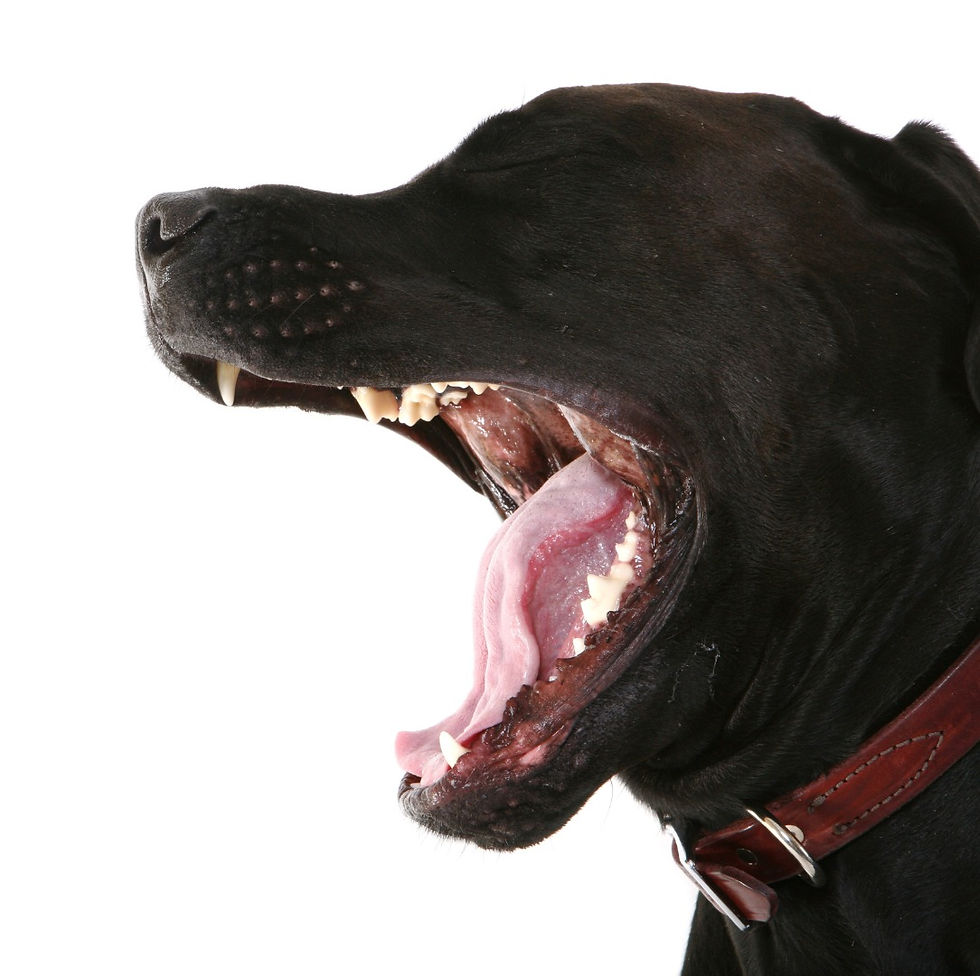7 Signs Dogs Display When They Are Anxious, Stressed Or Nervous
- Dr. Kristi Diaz MD

- Feb 19, 2023
- 4 min read

Anxiety in dogs is a common problem that can manifest in a variety of ways. While some dogs may have mild signs, others may experience more severe symptoms that can have a significant impact on their quality of life. It is important to recognize the signs of anxiety in your dog and take steps to help them manage it.
1. Excessive Barking and Howling: Dogs that are anxious may bark or howl excessively, often in response to loud noises or when they feel threatened. It is a way for them to express their fear and anxiety. This can be disruptive and can make it difficult for the dog to relax.
They may also bark and howl to alert their owners of potential danger or to seek comfort and attention. It can be a sign that the dog is feeling overwhelmed and needs help calming down. It's important to remain calm and provide reassurance when your dog is displaying signs of nervousness. If the barking and howling continues, you should consider seeking professional help to determine the underlying cause of the behavior.
2. Destructive Chewing: When a dog is anxious, they may engage in destructive chewing, such as chewing on furniture or other items in the home. It's a natural instinct for them to try to alleviate their stress and fear. This can be a sign that the dog is trying to cope with their anxiety.
Chewing and destroying objects can be a way for them to release their pent up energy, and it can even be a way of self soothing. It's important to remember that a lot of times, the behavior is out of their control, so it's important to be patient and understanding when it happens. If you think your pup is chewing and destroying things due to anxiety, there are things you can do to help them, like providing them with chew toys, engaging them in activities that help to reduce their stress or use a natural safe calming chew.
This is an indestructible chew toy coated with CBD which allows them to chew when they are nervous and get some CBD in their system at the same time.
3. Excessive panting: Panting is a normal behavior in dogs, but when it is excessive and frequent, it can be a sign that the dog is feeling anxious or stressed. If your dog is panting excessively, it is important to take note of the environment and any triggers that could be causing the anxiety. If necessary, consult with a veterinarian to determine the best course of action.
4. Excessive pacing: Excessive pacing back and forth in a dog can be a sign of anxiety and stress. This behavior is often seen in dogs that are feeling overwhelmed or anxious in their environment. It is a way to burn off some of their extra energy.
Pacing is also a way for them to search for something that may make them feel more secure, such as a toy or a person they recognize. This can help them to relax and feel more at ease.
It can be a sign that the dog is feeling uncomfortable and needs some extra attention and care. If you notice your dog pacing excessively, it is important to take the time to assess the situation and try to determine the cause of the anxiety. If the cause is identified, you can then work on providing your dog with the proper care and support to help them manage their stress and anxiety.
5. Excessive licking: Excessive licking in a dog can be an indication of anxiety and stress. Dogs may lick themselves, objects, or people as a way of self soothing or calming themselves down. This behavior may be seen in situations where the dog is feeling overwhelmed or stressed, such as when there are loud noises or unfamiliar people in the home. If you notice your dog licking excessively, it is important to take steps to reduce their stress and anxiety levels. This could include providing them with a safe space, distraction toys, or calming aids. Additionally, consulting a veterinarian or a certified animal behaviorist may be beneficial in order to identify the underlying cause of the behavior.
6. Excessive shedding: Excessive shedding in a dog can be an indication of underlying anxiety and stress. Shedding is a natural process for dogs, but when it becomes excessive, it can be a sign that the dog is feeling overwhelmed and needs help. If your dog is shedding more than usual, it is important to take steps to reduce the stress and anxiety in their life. This may include providing them with a comfortable and secure environment, engaging in regular exercise, and providing them with mental stimulation. Additionally, it is important to consult with your veterinarian to ensure that there are no underlying health issues that may be causing the excessive shedding.
7. Trembling or shaking: Dogs tremble or shake when they are nervous because it is a physiological response to fear or stress. This response is driven by hormones released by the body when it is feeling anxious or frightened. The trembling may also be a sign of pain or illness, so if your pet is displaying this behavior for prolonged stretches of time or on a recurring basis, it is important to take them to the vet for an examination. It is important to address any underlying issues that may be causing the anxiety and stress so that your dog can remain calm and comfortable.















Comments